This was published 3 years ago
Qantas turns 100 years old: Australia's first airline marks a century of flying
By Michael Gebicki
Qantas is turning 100. On November 16 1920, Queensland and Northern Territory Aerial Services Limited was founded at Winton, Queensland. The evolution from outback Queensland mail service with just one single-engine biplane to one of the world's leading airlines is a ripping yarn. Here's how it all began, and some of the milestones along the way.
In the beginning
The Qantas story has its roots in March 1919, when Wilmot Hudson Fysh and Paul McGinness, former lieutenants who had served in the trenches of Gallipoli, the Palestine Campaign and subsequently as flyers in the Australian Flying Corps, renewed their friendship. The motivation was a £10,000 prize offered by the Commonwealth Government for the first Australians to fly from England to Australia in less than 30 days.
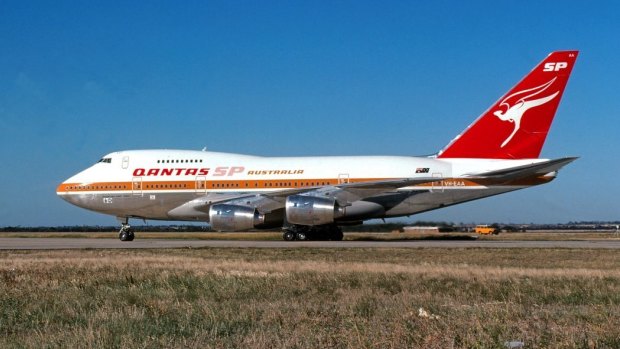
Qantas Boeing 747, circa 1980s.Credit: Courtesy of Qantas
McGinness set off to visit Sir Samuel McCaughey to see if he would stump up the funds for a suitable aircraft. McCaughey was a wealthy grazier who, together with his brother, had donated the Bristol F2B Fighter aircraft that Fysh and McGinness had flown together in the Middle East. The grazier was keen, but died before a suitable aircraft was found, and the executors of his estate refused to fund the venture.
Fysh and McGinness might have gone their separate ways, but both were from a rural background and their wartime flying experience had shown them the benefits that aviation could bring to the pastoral industry, particularly to graziers on remote outback cattle properties, where the vehicles of the time were ill-suited to rough tracks and river crossings that were frequently washed away by floodwaters.
A syndicate of graziers headed by Fergus McMaster agreed to fund the venture, an aircraft was ordered and so began Queensland and Northern Territory Aerial Services Limited, later shortened to the acronym QANTAS. A few weeks after it was founded, Qantas shifted its headquarters to the town of Longreach.
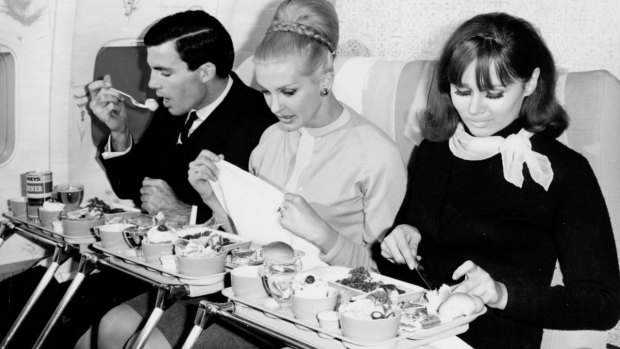
Food service on a Qantas B707-138, circa 1960s.Credit: Courtesy of Qantas
The first Qantas aircraft was an Avro 504K biplane, built from timber and cotton fabric and originally developed as a military aircraft during World War I. After initial operations as a mail service between Charleville and Cloncurry, Qantas carried its first paying passenger in 1922, an outback pioneer by the name of Alexander Kennedy, just short of his 85th birthday, who was given the airline's ticket No. 1.
Qantas goes international
In 1935 Qantas began operating its first international service, a flight between Darwin and Singapore, taking two days aboard a De Havilland 86 biplane. This was a link in a new air route that connected Australia with the UK. At Singapore, passengers would board an Imperial Airways service for the long flight to England. That same year the airline changed its name to "Qantas Empire Airways Limited", reflecting its international focus.
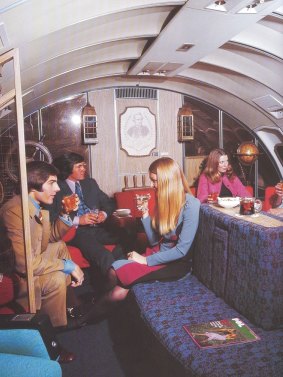
First Class Lounge on a Boeing 747, circa 1970s.Credit: Courtesty of Qantas
From 1938, Empire flying boats began operating between Sydney's Rose Bay and Singapore. Empire flying boats featured a promenade cabin, galley, wine cellar, in-flight meal service and space to stroll about and socialise. The windows of the promenade cabin were placed at standing height to allow passengers to take in the view, since the cruising speed was a leisurely 240 km/h at a maximum altitude of 5000 feet (1525 metres).
A long time in the air
Qantas holds the record for the world's longest scheduled passenger flights by elapsed time, an accolade it has held for close to 80 years. To maintain the vital Australia-UK air link during World War II, from 1943, RAAF pilots began flying Qantas Catalina flying boats non-stop between Western Australia and Ceylon, now Sri Lanka. With Singapore under Japanese occupation the original route was no longer possible. Covering 6480 kilometres, at an average speed of 200 km/h, the flight took between 27 and 33 hours.
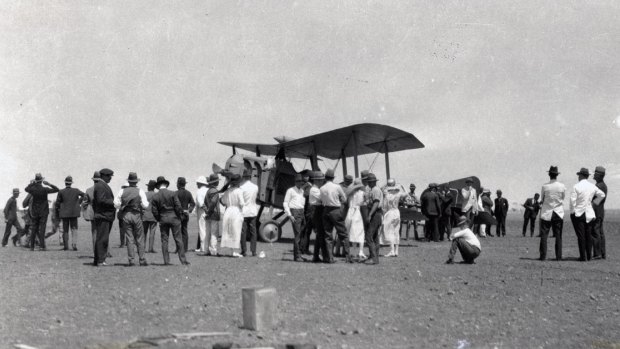
Qantas First mail and passenger flight, FK8 aircraft at Longreach, November 1922.Credit: Courtesy of Qantas
According to David Crotty, Curator of Qantas' Heritage Collection, "the Catalina's navigators used celestial navigation by taking sightings of the sun, stars and planets to plot their position as they flew over a featureless ocean with no position checks except the Cocos Islands. As they were flying through areas patrolled by Japanese ships and aircraft, radio silence had to be maintained until approaching the bases at Koggala Lagoon, Ceylon and the Swan River, Perth.
Primary navigation was the job of a highly skilled navigator using an RAF Mark IXB bubble sextant to take at least three sightings of celestial bodies, and by measuring their angle with the horizon and plotting an estimated triangulated position on a map. Variables such as wind speed and direction could be measured by using a drift sight to record smoke released by a "smoke float" dropped from the Catalina onto the ocean surface.
The five Qantas Catalinas were named after primary stars used by navigators, Antares, Rigel, Spica, Altair and Vega. In all, 271 safe crossing were made carrying 113,760 pounds (51,600 kilos) of mail and 648 passengers (maximum three per trip). Much of the mail was microfilmed to save weight. Each passenger received a certificate awarding membership to the "Rare and Secret Order of the Double Sunrise" for the flight.
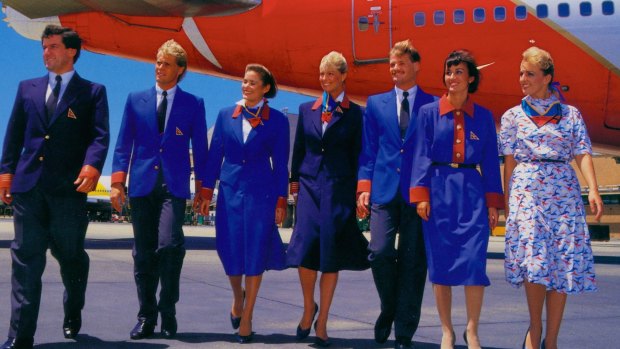
Qantas Yves St Laurent uniforms, circa 1980s.Credit: Courtesy of Qantas
Joining the jet age
In 1958 Qantas began operating a round-the-world service using four-engine Super Constellations. In March of the following year, Qantas took delivery of its first jet-engine aircraft, a Boeing 707, the first of its kind to be sold outside the USA. The aircraft, City of Canberra, was used on trans-Pacific flights to San Francisco, with refuelling stops in Fiji and Hawaii. The Qantas fleet would eventually include seven Boeing 707s.
In 2006, after a lifetime of work with Canadian airline Pacific Western and as the personal transport of Saudi Arabia's Prince Bandar bin Sultan Al Saud, the original City of Canberra Boeing 707 returned to Australia after a huge restoration project in the UK. Much of the work was done by retired Qantas engineers who spent six months restoring the aircraft. Although City of Canberra had stood idle for several years it was generally sound apart from corrosion in the tail, with 12 birds' nests at the base of the fin, some with eggs.
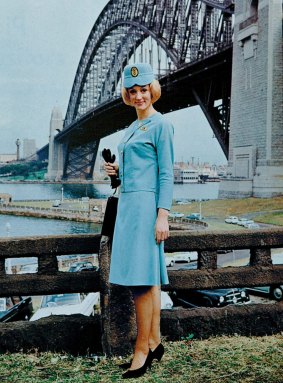
Qantas 1964-1969 female cabin crew uniform.Credit: Courtesy of Qantas
The homeward journey to Australia began with a trans-Atlantic leg with a stop in Orlando, Florida, where the crew welcomed John Travolta on board, dressed in a Qantas captain's uniform, since at the time Travolta was a Qantas ambassador. Travolta has his own Boeing 707, a former Qantas aircraft repurposed as an executive jet, complete with a double bed and showers, leather upholstery and cocktail bar. City of Canberra now rests at the Qantas Founders Outback Museum in Longreach.
Qantas brings non-stop flights to the kangaroo route
More than three decades ago, a more recent City of Canberra, a Qantas Boeing 747-438, became the first aircraft to fly non-stop from London to Sydney. With just flight crew, two cabin crew and 16 passengers to save weight, its fuel tanks topped up to overflowing, this was the first commercial aircraft ever to attempt a journey of this length, over 17,000 kilometres.
Flying an optimal route to take advantage of favourable winds, the flight was textbook, until over the Indian Ocean came the news that Sydney was shrouded in thunderstorms and low cloud, with wind gusting to 40 knots and visibility down to three kilometres. Flight control in Sydney was advising a 30-minute holding requirement, but that meant City of Canberra would run out of fuel. The flight crew decided to press on and luck was on their side. The weather cleared enough to make a landing and at 2:20pm Sydney time, City of Canberra returned to earth, 20 hours and 9 minutes after its wheels left Heathrow.
In March 2018 another Qantas aircraft followed in its wake when Qantas began operating its daily QF9 non-stop service between Perth and London, aboard a Boeing 787-9 Dreamliner, capable of carrying up to 236 passengers on the world's third longest commercial flight. Travellers can take in the Boeing 747-438 that made the historic London-Sydney non-stop flight at the Historical Aircraft Restoration Society located at Wollongong Airport at Albion Park, just over an hour's drive south of Sydney.
A long way from home
Qantas flight QF63, from Sydney to Johannesburg, travels further from any airport at which it could land than any other commercial airline flight. The flight path takes the aircraft in a great circle route of more than 11,000 kilometres, dipping towards Antarctica. In about mid-flight the aircraft passes over the Kerguelen Islands. At that point Perth is 4232 kilometres away. The closest airport at which the aircraft could land is Durban, on the east coast of South Africa, 3878 kilometres away.
Before the service was suspended due to the current pandemic, Qantas had been operating a Boeing 747 on this route, which has a substantial safety margin since the aircraft can remain airborne with just one if its four engines operating. However new generation aircraft such as Airbus' A350XWB and Boeing's 787 Dreamliner have an ETOPS (Extended-range Twin-engine Operational Performance Standards) rating of 5½ hours or more, the amount of time these aircraft are certified to fly on one engine. This would allow them to operate safely on the Sydney-Johannesburg route. Qantas has operated flights between Australia and South Africa since 1952, initially using a Lockheed L749 Constellation, with refuelling stops at the Cocos Islands and Mauritius.
Five more Qantas facts
- Qantas Liberator aircraft, which the airline began flying in 1944, were the first to sport the Flying Kangaroo, the distinctive motif seen on the tail of Qantas aircraft.
- Qantas is the world's oldest airline in continuous operation. KLM is slightly older but it ceased operations during WWII.
- In 1979, Qantas became the first airline to introduce Business Class. Launched on the 747 on flights between Australia and the US, the new class offered roomier seats and upgraded inflight service.
- When Qantas adopted a new uniform for its flight crew in 2016, it reverted to the white-topped cap not seen on the heads of Qantas pilots since decades earlier, a nod to the days when pilots' uniforms were derived from the smart design of a naval dress uniform.
- Since 1994, the Qantas Flying Art Series has seen the airline's aircraft painted with striking Indigenous artworks developed by Indigenous-owned design agency, Balarinji, in collaboration with Aboriginal artists and their representatives.
Qantas museums
Travellers can see some of the famous aircraft that have served in the airline's fleet at the Qantas Founders Museum in Queensland's Longreach. The Qantas Heritage Collection in terminal 3 at Sydney Airport features historic photos, uniforms and aircraft components. See qantas.com
See also: 'COVID-19 has terminated my career': Hero of A380 flight QF32 grounded
See also: Last Qantas A380 makes final flight ahead of desert storage
Sign up for the Traveller newsletter
The latest travel news, tips and inspiration delivered to your inbox. Sign up now.